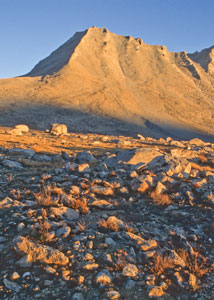The Sierra Nevada boasts a rich history of exploration that is
obscured by the more romantic and important story of the Gold
Rush
The Sierra Nevada boasts a rich history of exploration that is obscured by the more romantic and important story of the Gold Rush. Soon after the world rushed to California to extract the mountain range’s mineral riches, a succession of avid mountaineers explored the inner reaches of it for the sheer joy of doing so. They were attracted to the high country for the same reasons we visit the wilderness today: solitude and breathtaking beauty.
What makes these mountaineers so interesting is that they did not have all of the technical gear available to climbers today. They strapped on hobnail boots, studied the mountain for an accessible route and scrambled up as best they could. Make no mistake; while many of the routes they pioneered are easy by today’s standards, the feats they performed without the benefit of modern equipment required astonishing strength and skill.
I have been reawakened to these men and women (yes!) by a new book by Dan Arnold, “Early Days in the Range of Light: Encounters with Legendary Mountaineers.” In his book, Arnold, a climber himself, has retraced the paths of some of these early mountaineers up 15 important peaks in the high Sierra. On climbs dating from 1864 (John Muir on Cathedral Peak) to 1930 (Norman Clyde on Norman Clyde Peak), Arnold follows the routes of each first ascent using only the backcountry equipment the original climbers used.
Even before John Muir ventured into the Sierra, Josiah Whitney was appointed State Geologist with instructions to do a complete geological survey of California. While Whitney was the nominal leader of the survey, William H. Brewer led the day-to-day field work from 1860-64. He left a very interesting and readable journal of his travels entitled “Up and Down California.” The journal describes the full length and breadth of a virtually untouched California including many visits to many local features (e.g., New Almaden, Pacheco Peak. My copy includes a sketch of Hollenbeck’s Rock, aka Lover’s Leap on Pacheco Pass). But most famous is a story that begins on the Great Western Divide in what is now Kings Canyon National Park.
Using their own navigational skills and the advice of shepherds who ventured into the high country, the survey constantly sought to climb high spots from which they could do their survey work. In July of 1864, they reached the summit of what they would name Mount Brewer (13,570 feet) expecting to look down into the Owens Valley on the far side of the range. To their surprise, peaks reach for miles to the east, a great many higher than Mount Brewer.
A young and energetic Clarence King asked Brewer’s permission to strike out toward a peak he was sure was the highest in the range. His traverse of the range is still regarded as one of the greatest mountaineering achievements in the Sierra. It culminated in an ascent of Mount Tyndall (14,018 feet) that King describes in greatly exaggerated death-defying language. When King and Richard Cotter, another member of the California Geological Survey, reached the summit, they were once again disappointed to see a number of higher peaks.
The John Muir Trail passes very close to Mount Tyndall. When my son and I hiked the trail, I had hoped to include a side trip up King’s route to the summit of Tyndall, but bad weather ruled it out. A few weeks after our trip, I returned to Tyndall alone.
From camp near the mountain’s base, I left early in the morning to retrace King’s climb. The route up the North Rib is an exhilarating climb, not death-defying in the least. It was a special moment. Alone on the summit that calm and perfect day, I thought of King and felt the simple pleasure of the early mountaineer.








